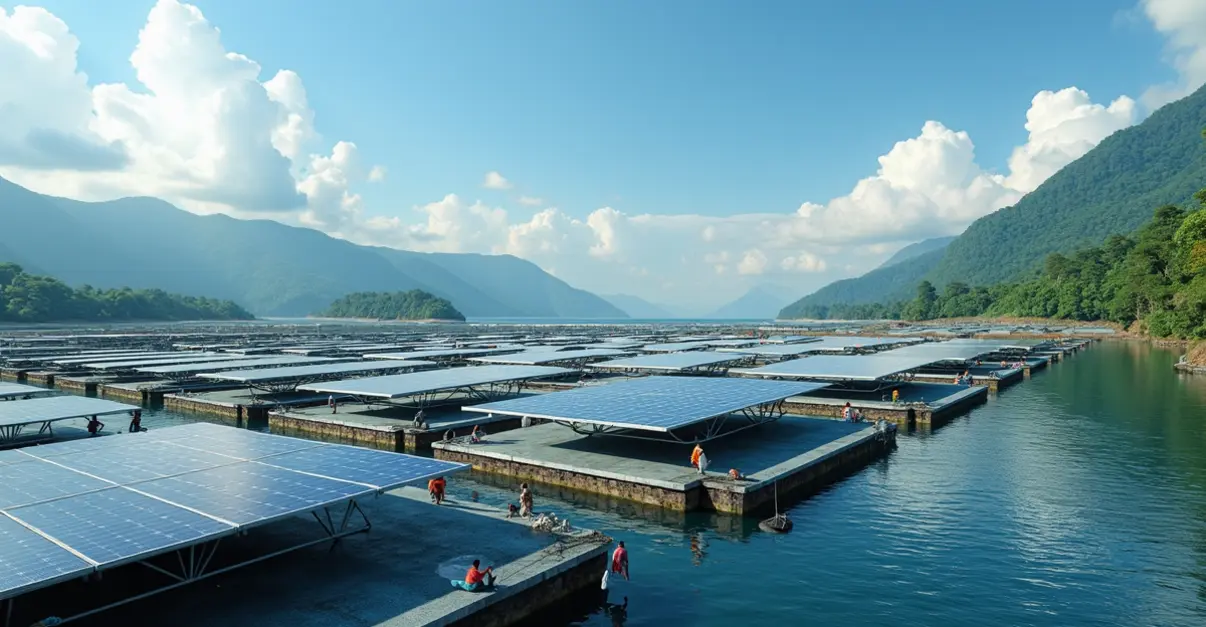Southeast Asian countries are rapidly deploying floating solar farms on reservoirs, achieving dual benefits of clean energy generation and water conservation. Major projects in Indonesia, Singapore, Malaysia and the Philippines demonstrate 5-15% efficiency gains through water cooling.

Revolutionizing Renewable Energy in Southeast Asia
Southeast Asian nations are rapidly embracing floating solar technology as a groundbreaking solution to their energy and water management challenges. By installing solar panels on reservoirs and lakes, countries across the region are creating dual-purpose facilities that generate clean electricity while conserving precious water resources. 'This represents a paradigm shift in how we approach renewable energy development in land-scarce regions,' says Dr. Mei Lin, a renewable energy expert at the Asian Development Bank.
Major Projects Leading the Way
Indonesia is developing what could become the world's largest floating solar complex at Duriangkang Reservoir with a potential capacity of 2.2 GW. 'The scale of this project demonstrates our commitment to clean energy while maximizing our natural resources,' notes Indonesian Energy Minister Arifin Tasrif. Meanwhile, Singapore is constructing its largest floating solar farm at Kranji Reservoir, scheduled to begin construction in 2025 with a capacity of 150 MWp.
In Malaysia, Sarawak Energy Berhad is planning a massive 300 MW floating solar installation at the Bakun hydroelectric dam reservoir, with potential to expand to 1,000 MW. 'This hybrid approach combining hydro and solar power creates a more resilient energy system,' explains Sarawak Energy CEO Datuk Sharbini Suhaili. The Philippines is also making significant strides with its 2,000-hectare Laguna Lake project scheduled for completion in 2026.
Technical Advantages and Efficiency Gains
Floating solar panels offer substantial efficiency improvements over traditional land-based systems. The natural cooling effect of water increases energy output by 5-15% compared to conventional solar farms. 'The water cooling effect is like having a built-in air conditioning system for the panels,' explains Dr. Kenji Tanaka, a solar technology researcher at the National University of Singapore.
Beyond energy generation, these installations provide crucial water conservation benefits. Studies show floating solar can reduce water evaporation by up to 25%, a significant advantage in regions facing water scarcity. The shade provided by the panels also inhibits algae growth, improving water quality for surrounding communities.
Regional Growth and Market Potential
The global floating solar market is projected to grow from $38.50 billion in 2023 to $196.49 billion by 2031, with Southeast Asia positioned to become a global hub for this technology. Vietnam alone has identified potential for 21-46 GW of floating solar capacity in its reservoirs and 21-54 GW in natural water bodies.
By early 2024, Southeast Asia is expected to add 300 MW of floating solar capacity, contributing significantly to regional decarbonization goals. 'Floating solar represents one of the most promising pathways to achieving our Paris Agreement commitments,' states ASEAN Energy Cooperation Director Maria Santos.
Environmental and Economic Benefits
The dual-purpose nature of these installations addresses multiple challenges simultaneously. 'We're not just generating electricity - we're creating smarter water management systems while preserving land for agriculture and conservation,' notes environmental scientist Dr. Chen Wei from the University of Malaya.
Economic benefits extend beyond energy production. The development of floating solar projects creates local jobs in manufacturing, installation, and maintenance. Governments across the region are supporting this growth through financial incentives and streamlined approval processes, recognizing the technology's potential to drive sustainable economic development.
Future Outlook and Challenges
As Southeast Asia continues its renewable energy transition, floating solar is expected to play an increasingly important role. The region's abundant water resources and high solar irradiance create ideal conditions for this technology to flourish. However, challenges remain, including ensuring system durability in tropical conditions and minimizing environmental impacts on aquatic ecosystems.
'The key to success will be continued research and strong public-private partnerships,' concludes Dr. Lin. 'We're only beginning to tap the potential of this transformative technology.'

 Nederlands
Nederlands
 English
English









